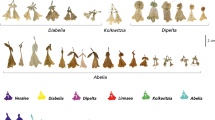Abstract
The present revision ofSolanum sect.Brevantherum Seithe recognizes 12 species in North and Central America, 5 of which (S. brevipedicellatum, S. axillifolium, S. atitlanum, S. pulverulentifolium, and S. chiapasense) are described as new. The traditional methods of comparative morphology are employed in delimiting the species in the herbarium, but pertinent data from field work are also included. Some of the most diagnostic features are those associated with the buds, calyces, and hairs. A key to the species is based on both vegetative and floral characters. Distribution maps show the widespread nature of some species and the endemism of others. All of the species are weedy and are associated with secondary growth vegetation.
Similar content being viewed by others
Literature Cited
Bitter, G. 1917. Solana africana. II. Revision der afrikanischen Solanum-Arten mit Ausschluss der SektionMorella. Bot. Jahrb.54: 416–506.
Budowski, G. 1959. The ecological status of fire in tropical American lowlands. Congreso Internacional de Americanistas1: 264–278. (Bol. Mus. Cienc. Nat. 4–5(1/4): 113–127. 1958–1959.)
Don, G. 1838. A General History of the Dichlamydeous Plants, comprising complete descriptions of the different orders. Vol. 4. London: Rivington. viii + 908 pp.
Dunal, M. F. 1852. Solanaceae.In: DC., Prodr.13(1): 1–673.
Kunth, C. S. 1847. Species novae et emendatae Horti Regii Botanici Berolinensis. Ann. Sci. Nat. Bot. III.7: 181–189.
Morton, C. V. 1944. Taxonomic studies of tropical American plants. Contr. U. S. Nat. Herb.29: 1–86, i-xi.
—, &R. E. Schultes 1942. Localidades visitados y rutas recorridas por E. W. Nelson en el Estado de Oaxaca. Anales Inst. Biol. México13: 47–51.
Richards, P. W. 1952. The Tropical Rain Forest; an Ecological Study. Cambridge, England: University Press. xviii + 450 pp.
Roe, K. E. 1966. Juvenile forms inSolanum mitlense andS. blodgettii (Solanaceae) and their importance in taxonomy. Sida2: 381–385.
-. 1968.Solanum verbascifolium L., misidentification and misapplication. Taxon 17: (in press).
Schulz, O. E. 1909. Solanacearum genera nonnulla.In: Urban, I., Symbolae Antillanae6: 141–279.
Seithe, A. 1962. Die Haararten der GattungSolanum L. und ihre taxonomische Verwertung. Bot. Jahrb.81: 261–335.
Standley, P. C. 1938. Flora of Costa Rica. Field Mus. Publ. Bot.18(3): 783–1133.
Urban, I. 1920. Sertum Antillanum. VIII. Repert. Sp. Nov.16: 32–41.
Author information
Authors and Affiliations
Additional information
Based on a thesis submitted in partial fulfillment of the requirements for the degree of Master of Science at the University of Wisconsin, Madison, June, 1966. I am especially grateful to Dr. Hugh H. Iltis for his guidance and encouragement throughout the study. Acknowledgments are also extended to Mr. Conrad V. Morton for his many valuable suggestions and to the curators of those herbaria from which specimens were borrowed. Support for this research was provided by a research fellowship, no. 5-Fl-GM-24,641, from the National Institutes of Health.
Rights and permissions
About this article
Cite this article
Roe, K.E. A revision of Solanum sect. Brevantherum (Solanaceae) in North and Central America. Brittonia 19, 353–373 (1967). https://doi.org/10.2307/2805534
Issue Date:
DOI: https://doi.org/10.2307/2805534




